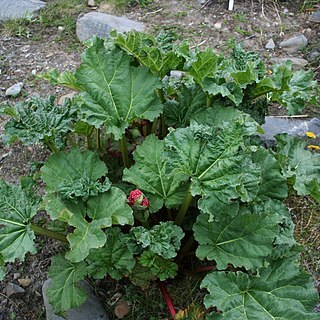Herbs large, 0.7-2 m tall. Rhizomes and roots stout. Stem sulcate, glabrous, pubescent only at nodes. Petiole of basal leaf equal to blade or slightly longer, pubescent; leaf blade ovate-elliptic or broadly ovate, large, 20-50 × 18-40 cm, abaxially pilose, basal veins 5-7, base cordate, margin entire, sinuolate, apex obtuse. Stem leaves ovate, narrow; ocrea large, pubescent, clasping. Panicle large, 2-or 3-branched, densely papilliferous. Pedicel muricate, jointed below middle. Perianth spreading, purple-red, 3-3.5 mm; outer 3 smaller, oblong-elliptic, ca. 1.5 × 1 mm; inner 3 very broadly elliptic or rarely orbicular, ca. 2.5 × 2 mm. Filaments subulate. Ovary rhomboid-obovoid; stigma oblate, muricate. Fruit ovoid-ellipsoid or broadly ellipsoid, 9-10 × 7-8.5 cm, base subcordate, apex retuse or not; wings purple-red, ca. 2.5 mm wide; longitudinal veins near margin. Seeds ovoid. Fl. Jun-Jul, fr. Aug or later.
More
A herb. It grows to about 1.5 m high. It spreads 1.5 m wide. The rootstock is woody. The leaves have stalks. The leaves are broadly oval or heart-shaped. There are some hairs on the veins underneath. The leaves have wavy edges. The flowering stalks are stout and red. The flowers are dark purple or white. They are small and in clusters. The fruit are oblong wand purple with wings. They are notched at the tip.
Moist scrub, open slopes on rocky ground, alpine meadows, forest margins; at elvations from 3,200-4,200 metres. Grassy slopes; at elevations from 3,400-4,300 metres in Tibet.
More
It is a temperate plant. It grows in Nepal from 3200-4200 m altitude. They grow in open, rocky places. It suits cold arid places. It suits hardiness zones 6-9.
The leaf stalks are cooked and eaten. They are also pickled, mostly after drying. They are also cooked, preserved in salt, made into preserves, or dried and stored. The leaves and flowers are also eaten. (Rutin is present in the leaves and flowers.) They are chopped, boiled and then fried. The plants are often blanched by covering with soil.

